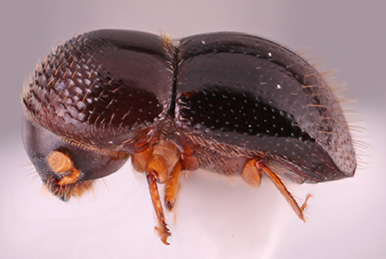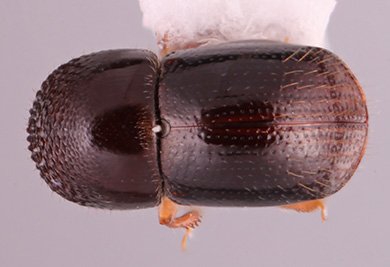Xylosandrus germanus
|
Xylosandrus germanus lateral; S.M. Smith |
|
Xylosandrus germanus dorsal; S.M. Smith |
|
Xylosandrus germanus declivity; S.M. Smith |
|
Xylosandrus germanus frontal; S.M. Smith |
Taxonomic history
Xyleborus germanus Blandford, 1894b: 106.
Xylosandrus germanus (Blandford): Hoffman, 1941: 38.
Synonyms
Xyleborus orbatus Blandford, 1894b: 123. Nobuchi, 1981b: 31.
Diagnosis
2.3−2.4 mm long (mean = 2.32 mm; n = 5); 2.3−2.56 times as long as wide. This species can be distinguished by its moderate size; elytralelytral:
'pertaining to the elytra
discdisc:
the flat central upper surface of any body part (e.g. pronotum and elytra) gradually curving toward declivitydeclivity:
gradually curving toward declivitydeclivity:
downward slope of either the pronotum or elytra
 , appearing rounded; posterolateralposterolateral:
, appearing rounded; posterolateralposterolateral:
'relating to end of the side part/portion
 margins of elytraelytron:
margins of elytraelytron:
'
the two sclerotized forewings of beetles that protect and cover the flight wings
carinate to interstriaeinterstria:
'longitudinal spaces along the elytra between the striae, which is not as<br />
impressed and bear smaller punctures.
 7; declivitaldeclivital:
7; declivitaldeclivital:
pertaining to the elytral declivity
face with six punctatepunctate:
'set with fine impressed points, appearing as pin pricks
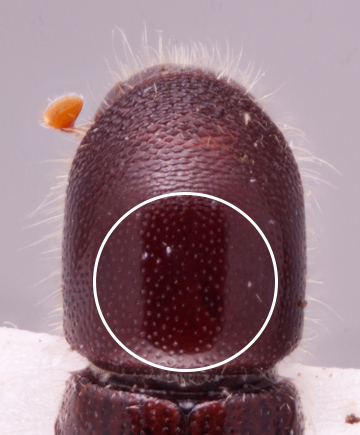 striae; declivitaldeclivital:
striae; declivitaldeclivital:
pertaining to the elytral declivity
interstriae granulategranulate:
'pertaining to a coarse, grainy surface texture'
 , uniseriate with erecterect:
, uniseriate with erecterect:
'pertaining to setae that have their apices directed away from the body and appear straight
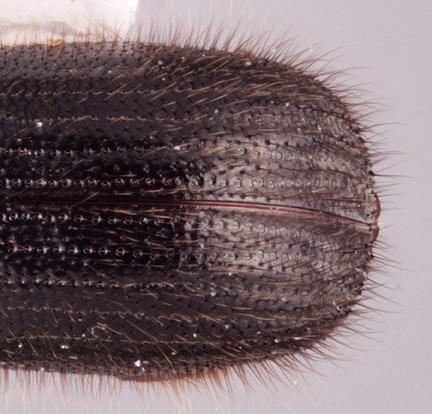 hair-like setaeseta:
hair-like setaeseta:
small hair-like or scale-like structure
longer than the width of 1.5 interstriae; pronotumpronotum:
'the dorsal surface of the thorax
1.1 times long as wide, pronotumpronotum:
'the dorsal surface of the thorax
from dorsaldorsal:
'of or relating to the upper surface; opposite of ventral
 view rounded (type 1) and laterallateral:
view rounded (type 1) and laterallateral:
'pertaining to the side
 view basic (type 0), summitsummit:
view basic (type 0), summitsummit:
highest point, used for pronotum and elytra, denotes the peak between pronotal frontal slope and disc, and between elytral disc and declivity at midpoint, basalbase:
at midpoint, basalbase:
point or edge closest to the body; opposite of apex half smooth, shiningshining:
half smooth, shiningshining:
appearing glossy or bright in luster; referring to a surface that is polished and reflects light well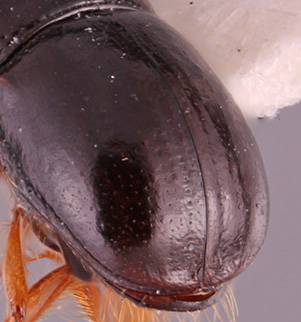 , sparsely minutely punctatepunctate:
, sparsely minutely punctatepunctate:
'set with fine impressed points, appearing as pin pricks
 ; and sparse mycangial tuftmycangial tuft:
; and sparse mycangial tuftmycangial tuft:
'tuft of setae that denotes the mycangia exterior opening
 on the pronotalpronotal:
on the pronotalpronotal:
'pertaining to the pronotum
basebase:
point or edge closest to the body; opposite of apex .
.
Xylosandrus germanus is nearly identical to X. eupatorii and is most easily distinguished by the pronotumpronotum:
'the dorsal surface of the thorax
1.1 times as long as wide and the pronotalpronotal:
'pertaining to the pronotum
basebase:
point or edge closest to the body; opposite of apex with more abundant and denser setaeseta:
with more abundant and denser setaeseta:
small hair-like or scale-like structure
, and from X. metagermanus by the smaller, shallower strial punctures and feebly impressedimpressed:
'a depression in a surface
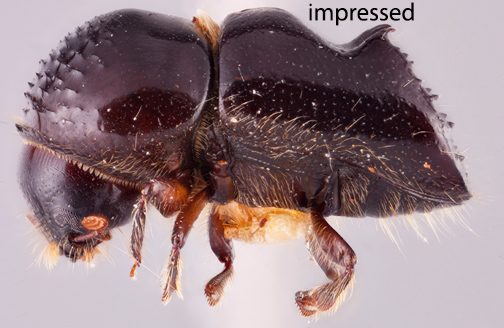 striae.
striae.
May be confused with
Anisandrus dispar, A. maiche, A. paragogus, Xylosandrus dentipennis, X. eupatorii, and X. metagermanus
Distribution
China (Anhui, Chongqing, Fujian, Guangdong, Guizhou, Guangxi, Hainan, Henan, Hubei, Hunan, Jiangsu, Jiangxi, Shaanxi, Shanxi, Sichuan, Xizang, Yunnan, Zhejiang), Japan, South & North Korea, Taiwan, Vietnam. Also present in Russia (Far East, Sakhalin, Kurile Is.). Introduced to and established in Europe and Turkey, USA (including Hawai’i) and Canada (Gomez et al. 2018aGomez et al. 2018a:
Gomez DF, Rabaglia RJ, Fairbanks KEO, Hulcr J. 2018a. North American Xyleborini north of Mexico: a review and key to genera and species (Coleoptera, Curculionidae, Scolytinae). ZooKeys 768: 19-68. https://doi.org/10.3897/zookeys.768.24697). The record in Dole and Cognato (2010) from Thailand is incorrect. The cited specimens belong to the closely similar species, Xylosandrus eupatorii.
Host plants
polyphagous (Weber and McPherson 1983bWeber and McPherson 1983b:
Weber BC, McPherson JE. 1983b. World list of host plants of Xylosandrus germanus (Coleoptera: Scolytidae). The Coleopterists Bulletin 37: 114-134., Dole and Cognato 2010Dole and Cognato 2010:
Dole SA, Cognato AI, 2010. Revision of Xylosandrus Reitter (Curculionidae: Scolytinae). Proceedings of the California of Science 61: 451-545.)
Remarks
The basic biology is described by Nobuchi (1981b), Weber and McPherson (1983a), and Ranger et al. (2016). Peer and Taborsky (2004, 2005) have studied male dispersal, variations in sex ratio, and outbreeding depression in the species. Ito et al. (2008) discuss the genetic structure of Japanese populations. Although usually attacking stressed trees, the species sometimes attacks apparently healthy and newly transplanted trees and shrubs (e.g. Nobuchi 1981bNobuchi 1981b:
Nobuchi A. 1981b. Studies on Scolytidae XXIII. The ambrosia beetles of the genus Xylosandrus Reitter from Japan (Coleoptera). Bulletin of the Forestry and Forestry Products Research Institute 314: 27-37., Ranger et al. 2010, 2015). Ranger et al. (2016) discuss the ecology and management of the species in ornamental plant nurseries in USA.
DNA data
Sequences available for COI and CAD.
COI: GU808713; GU808714; MN620089; MN620090; MN620091; MN620092; MN620093; OP617793
CAD: GU808634; GU808635; MN620346; MN620347; MN620348; MN620349; MN620350; MN620351; OP607223

